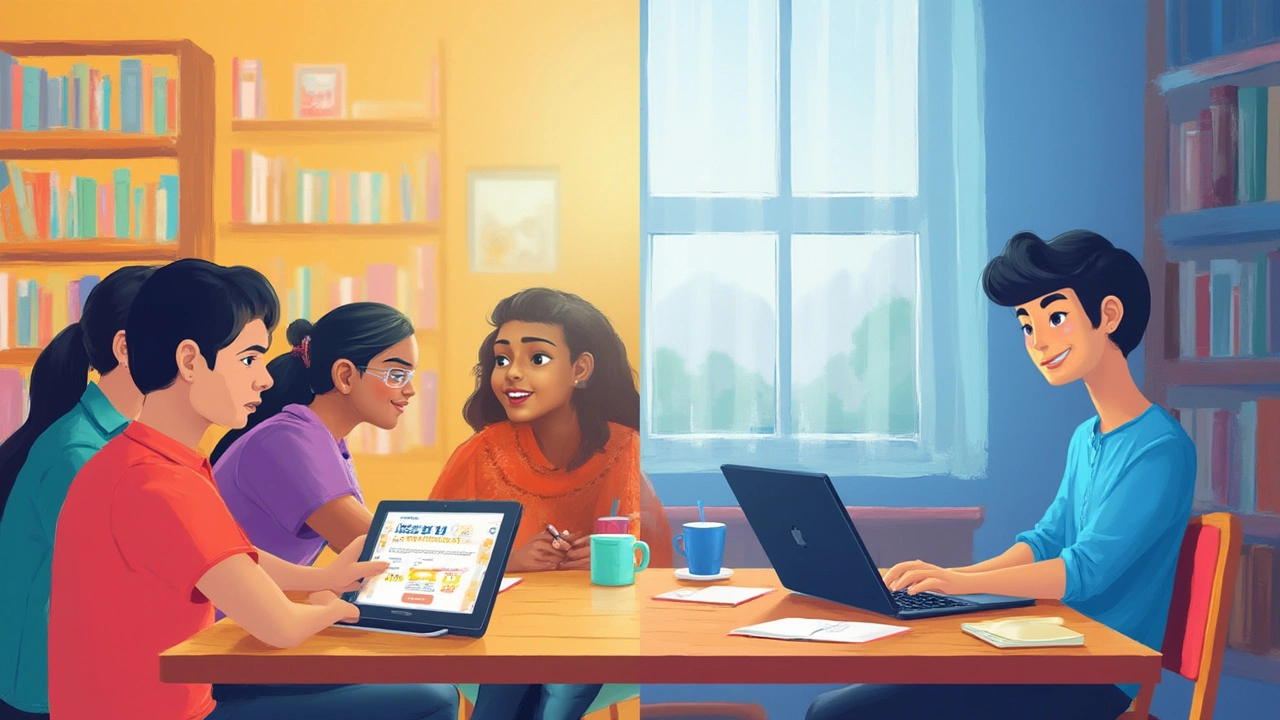
You don’t have to scroll far on social media to bump into someone sharing their latest online course certificate. Then you meet folks insisting, "Nothing beats a chalkboard and a teacher you can actually see." The debate between traditional and distance education is more than opinion—it's reshaping how millions access learning. Not too long ago, education meant sitting in a classroom, raising your hand, scribbling notes during lectures you couldn't replay. Now, some students join chemistry class in pajamas, halfway across the world, with coffee in hand. This isn’t just about what’s easier—it’s also about what works, what’s affordable, what sticks, and what connects people to opportunities.
The Heart of Traditional Education
Traditional education’s image is classic: students gathered in a room, a teacher guiding the discussion, physical textbooks stacked on desks, physical attendance, and immediate interaction. This face-to-face style has stood strong for centuries, with roots back to the world’s first universities. The routine, the ringing bells, the peer banter between classes—it all creates an environment steeped in structure. There’s a clear path: attend lectures, submit essay assignments, sit for exams in a silent hall. For most people over thirty, this is what comes to mind when you think "school."
What does traditional education excel at? You get instant feedback; you catch your teacher’s expression when you misunderstand something. Peer dynamics add “buzz”—debates spark creative thinking, making lessons memorable. Group work encourages accountability, friendships, and healthy competition. Sports, drama, and clubs mix learning with life beyond grades. Data backs this up: The National Center for Education Statistics (NCES) reports that students in physical schools have higher rates of social skill development and collaboration, especially in primary and secondary years. In-person settings often lead to higher persistence and graduation rates, especially when strong support systems are present. In countries like India or Japan, school culture is closely tied to social development—alumni networks, lifelong bonds, and even job opportunities often start in a classroom seat.
The most common tip for thriving in traditional education? Show up and dive in. Ask questions—even if you sound unsure. Join clubs and events, because real learning often spills out of textbooks and into conversations after class. If school feels overwhelming, grab a mentor—countless graduates say their best advice came not from scheduled lessons, but from a trusted teacher’s offhand comments. Cost-wise, brick-and-mortar schools can be expensive. There’s tuition, sure, but also travel, uniforms, supplies, and sometimes even housing. The latest UNESCO survey noted higher dropout rates among students with heavy commute times—so location is no small detail. Classic education does have its hurdles: strict schedules, limited flexibility for parents or working students, or fewer choices for people in remote areas. Still, the tried-and-true routines of traditional schooling create the backbone of education in a lot of cultures, shaping not just minds but confidence and community.

Distance Education: Freedom or Isolation?
If traditional education is about roots, distance education is about reach. Distance learning isn’t actually new—it stretches back to the 1800s, when correspondence courses delivered lessons by mail. Fast-forward to today, and distance education means video lectures, interactive forums, e-books, live webinars, and cloud-based projects. The technology shift exploded after the pandemic in 2020, when 1.6 billion students worldwide suddenly found themselves logging on instead of lining up in hallways. Today, platforms like Coursera, edX, and Udemy let you learn coding from an MIT professor—no visa required. A report from the Babson Survey Group showed that in 2023, over 80% of US colleges offered distance or hybrid courses, with enrollments still rising.
Freedom is what pulls most students to distance education. You can pace your lessons around a job, family, or even a side hustle. For single parents, rural learners, or people with disabilities, these options can open doors that used to stay shut. Thanks to digital libraries and instant playback, students can revisit tough topics anytime—no need to nervously raise your hand for a repeat. What makes distance education even more attractive? Lower costs: You skip the commute, pay less for materials, and sometimes grab scholarships aimed at online learners. According to BestColleges' 2024 survey, 73% of remote students report saving significant money compared to campus programs.
But remote classes aren’t all smooth sailing. There’s the challenge of motivation, for one. Without the subtle pressure of classmates or a teacher scanning the room, distractions multiply. The dog barks, the phone buzzes, and it’s suddenly three hours later with the assignment untouched. Some people miss the community vibe—discussion boards and group chats can't always replace honest, spontaneous conversations. Then there are tech headaches: unstable internet, software confusion, or just feeling "lost" without face-to-face explanations. Another hard truth? Online credentials don’t always carry the same weight in the job market—though that’s slowly changing, especially as recruiters get used to the remote revolution.
Thinking about jumping into distance learning? Set up a clear schedule—even if the class is self-paced. Work in sprints, not marathons, to fight boredom. Use video calls to make friends and ask teachers for one-on-one help. If you’re worried about isolation, look for online study groups or local meetups tied to your course. A huge tip: Create a tidy, distraction-free study zone at home. Even a simple desk in a quiet corner can work wonders. And remember—online students who seek out mentors and regularly join peer discussions are twice as likely to finish their courses, according to a 2023 Education Data Initiative survey.
| Feature | Traditional Education | Distance Education |
|---|---|---|
| Location | On-site classrooms | Anywhere with internet |
| Schedule | Fixed, structured | Flexible, self-paced |
| Cost | Often higher (tuition, travel) | Often lower (no commute, digital materials) |
| Social Interaction | Direct, daily engagement | Mostly virtual, sometimes limited |
| Feedback | Immediate (face-to-face) | Can be delayed (emails, forums) |
| Access | Limited by location | Global |

Which Option Suits You?
So you’re weighing which path to choose. There’s no one-size-fits-all answer—it’s about what fits your life, goals, and learning style. Traditional education is perfect for those craving routine, mentorship, and hands-on practice—think laboratory work, medical training, or performing arts. If you thrive on instant feedback, structured weeks, and real-life group projects, physical campuses are hard to beat. Want to build a network that outlasts graduation? Alumni events and campus culture hand you opportunities that go well beyond classwork. For subjects that really come alive through debate and in-person practice, going to school the old-fashioned way still delivers.
On the other hand, distance education lights up options you never thought possible. Maybe you’re working full-time, raising kids, or need flexible hours for health reasons. Or maybe you have a quirky passion—like Scandinavian architecture or quantum computing—and can’t find a local program. With distance learning, you’re not limited by what’s offered in your zip code. Tech-savvy, self-motivated types love the freedom to binge lessons or squeeze in studies at odd hours. Even universities like Harvard and Stanford now run online courses that offer genuine credentials. A 2023 Statista survey found that 60% of employers are now familiar with—or have hired—graduates of online programs. That number keeps climbing each year.
The smartest move? Be honest about what motivates you. Do you need face-to-face nudges or are you happiest setting your own pace? If you’re nervous about online learning, test-drive a short course before signing up for a full degree. Pro tip: Combine both worlds. Hybrid programs let you meet up for labs or exams but finish much of the work from home. Loads of companies also encourage short-term online certifications that upgrade your skills without quitting your job. In fast-changing industries (like tech or digital marketing), continuous online learning isn't just an option—it's almost expected.
Here’s a quick checklist to help you decide:
- traditional education—you crave live class debates, need close supervision, or want to join sports and campus events.
- Distance education—you want freedom, need to balance work/family, or love learning at your own speed.
- Both—hybrid options (look for “blended” or “flex” programs) for the best of both worlds.
With all the hype, don’t forget: learning is about growth, not just jumping through hoops. There’s a famous study from the Bill & Melinda Gates Foundation showing that students who believe they have a say in how they learn are more likely to stick with their studies—whatever the format. If you’re curious, hungry to explore, and willing to adapt, either path can work. Even if you start one way and change your mind, the doors aren’t locked. What's certain today—no matter where you learn—is that education now has more flavors than ever. You can blend, switch, or go all-in on the model that fits your real life. And who knows? The best teacher you’ll ever meet could live next door—or 10,000 miles away, waiting for your webcam to switch on.





